istetiana/iStock/GettyImages
You have to balance time and temperature to cook a boneless rump roast to maximum tenderness. Collagen -- the culprit responsible for meat's toughness -- liquefies between 160 and 180 degrees Fahrenheit. However, it takes about 45 minutes to render the collagen in 1 pound of meat -- long enough to render the moisture in the muscle fibers, as well. That's where braising comes in. Braising, or cooking with liquid at a low temperature, keeps the roast enveloped in moist heat and prevents the surface from drying, while the melting connective tissue, now called gelatin, coats individual muscle fibers and makes them easier to break apart when chewed.
Place the roast in a food storage container the night before and cover it with cultured buttermilk. Acidic marinades, such as those with lemon juice, do a better job of adding flavor than tenderizing, and actually make meat tougher if they sit too long on the surface of meat. Buttermilk, however, derives its tenderizing properties from lactic acid, which works with enzymes present in meat to "age" muscle fibers through enzymatic action.
Rinse the buttermilk from the roast the next day. Pat the roast dry with paper towels and let it sit at room temperature for 20 to 30 minutes.
Season the rump roast on all sides with kosher salt and freshly ground black pepper. It's best not to use dried spices, since you'll add aromatic ingredients.
Heat a couple tablespoons of oil or a combination of oil and butter in a Dutch oven or heavy-bottomed pan on the stove over medium-high heat for about five minutes. Dutch ovens work well with braises because you can go from the stove to the oven without removing the roast, but any heavy-bottomed pan will do for now.
Place the roast in the pan and sear it on all sides until golden-brown, about five minutes total. Use tongs to turn the rump roast over then needed. Heat the oven to 300 degrees.
Remove the rump roast and set it aside. Turn the heat on the stove to medium and add aromatic ingredients to the Dutch oven or pan. Use 1/2 cup of standard mirepoix -- 2 parts diced onion to 1 part each diced carrots and celery -- per pound of roast. You can add diced bell peppers and minced garlic to make a sofrito -- a Latin American mirepoix of sorts -- or fennel and lemongrass for an Italian flavor. Whichever you choose, cut the aromatic ingredients to uniform size.
Sweat the aromatic ingredients until fragrant and the onions translucent, about five minutes. Stir the veggies occasionally with a wooden spoon.
Place the rump roast back in the Dutch oven on top of the veggies. If you used a pan, transfer the veggies into a deep baking dish and place the roast on them.
Add enough stock or water and one or two cans of diced stewed tomatoes to reach halfway up the sides of the roast. During a braise, the acid in tomatoes causes a minor improvement in tenderization. Unlike marinating, the acid doesn't sit on the surface of the meat during a braise, but instead simmers and works with the low, moist heat to break down connective tissue within meat. Add fresh herbs to the liquid, if desired.
Cover the Dutch oven with the lid. If you transferred the roast to a baking dish, cover it tightly with a layer of plastic food film and wrap it with aluminum foil. The combination of plastic wrap and foil ensures the roast stays enveloped in moist heat during cooking. Ensure the plastic wrap does not extend down the exterior side of the dish.
Braise the roast until fork tender, or about 45 minutes per pound. Check the roast occasionally and add stock as needed so the moisture stays 1/4 up the sides of the roast at all times.
Remove the roast when it breaks apart easily with a fork. Let the roast rest, covered, for 30 minutes after you remove it from the oven. During the 30-minute rest period -- perhaps the most important 30 minutes of cooking a roast -- the meat absorbs a small amount of moisture and redistributes it, resulting in a juicy bite.
Related Articles
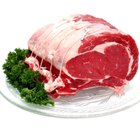
How to Marinate a Top Round Roast

How to Cook Beef Top Round Pot Roast
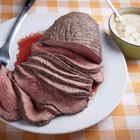
How to Cook a Roast in a Bag

How to Cook Axis Deer Steaks
How to Slow Cook a Pot Roast With Beef ...
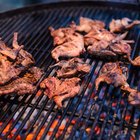
How to Cook a Partridge
How to Make a Bottom Roast
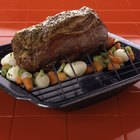
How to Cook a Really Tender Beef Roast ...
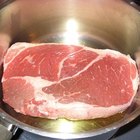
How to Cook a Tender Roast

How to Cook a Beef Roast in a Roaster ...

How to Cook a Tender Top Sirloin Roast

What Is the Difference in Top Sirloin & ...

How to Cook a 15-Pound Rib Roast
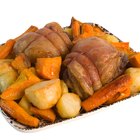
Calories in Beef Rump Roast

How to Cook a Rolled Beef Chuck Roast ...
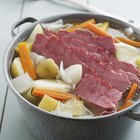
How to Cook a Large Amount of Corned ...
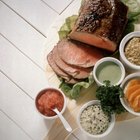
How to Cook a Roast in a Browning Bag ...

Shank Ham Cooking Directions

How to Make a Blackbuck Antelope Roast

How to Roast an Eye Round Roast at High ...
References
Writer Bio
A.J. Andrews' work has appeared in Food and Wine, Fricote and "BBC Good Food." He lives in Europe where he bakes with wild yeast, milks goats for cheese and prepares for the Court of Master Sommeliers level II exam. Andrews received formal training at Le Cordon Bleu.